Advance Management Accounting: ABM Implementation Effectiveness
VerifiedAdded on 2023/06/15
|19
|4751
|425
Report
AI Summary
This report examines the effectiveness of Activity Based Management (ABM) for smaller organizations and those with high indirect costs. It outlines the historical background of ABM, its relation to Activity Based Costing (ABC), and the implementation process. The research employs a survey technique for data collection, converting responses into percentage values for analysis. Quantitative analysis includes descriptive techniques and central tendency measures. Key research questions address the effectiveness of ABM implementation in organizations with high indirect costs and in smaller organizations. The report also covers the output of ABM information systems, a checklist for ABM implementation, and associated costs. It concludes with expected outcomes, data analysis methods, and recommendations for successful ABM adoption.
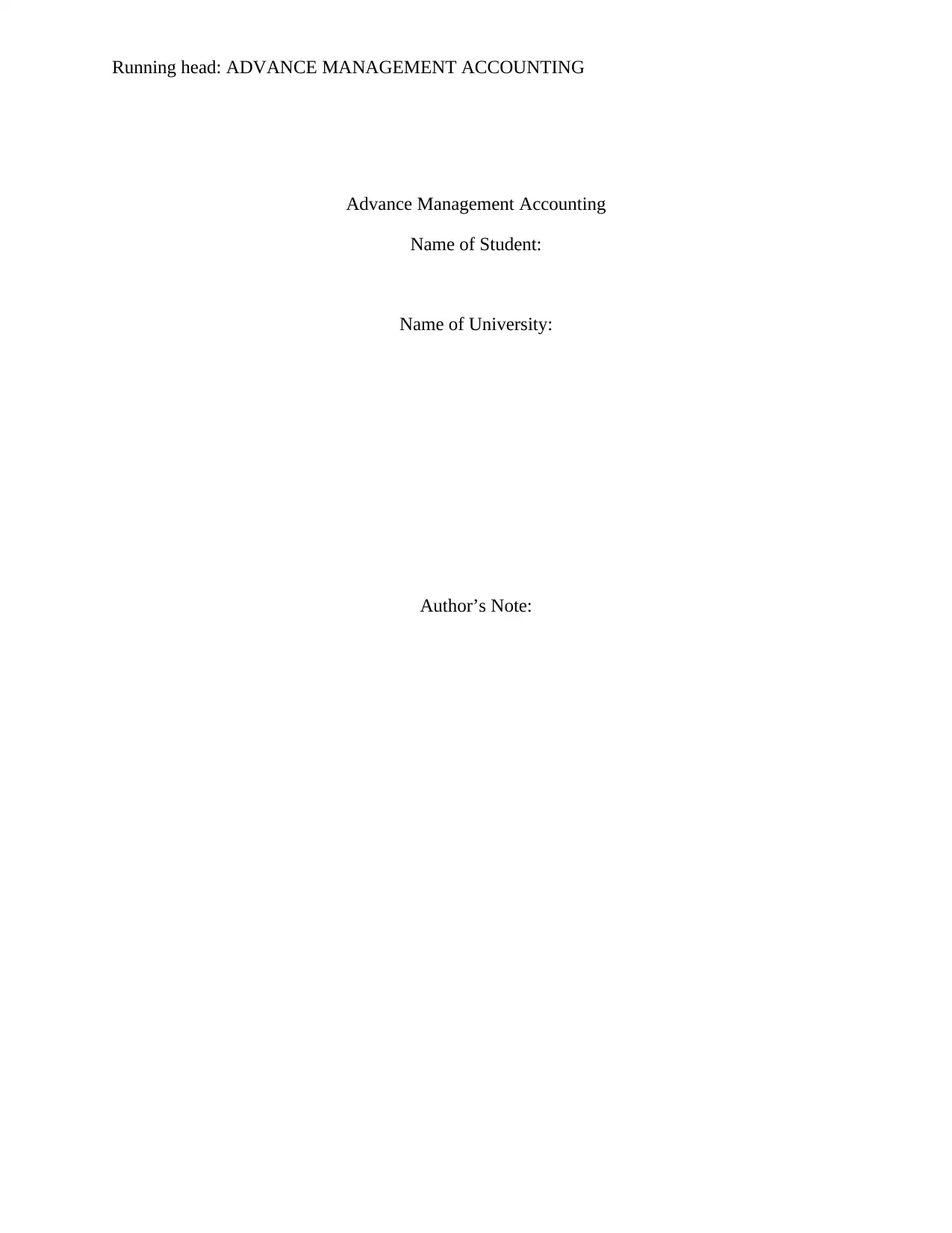
Running head: ADVANCE MANAGEMENT ACCOUNTING
Advance Management Accounting
Name of Student:
Name of University:
Author’s Note:
Advance Management Accounting
Name of Student:
Name of University:
Author’s Note:
Paraphrase This Document
Need a fresh take? Get an instant paraphrase of this document with our AI Paraphraser
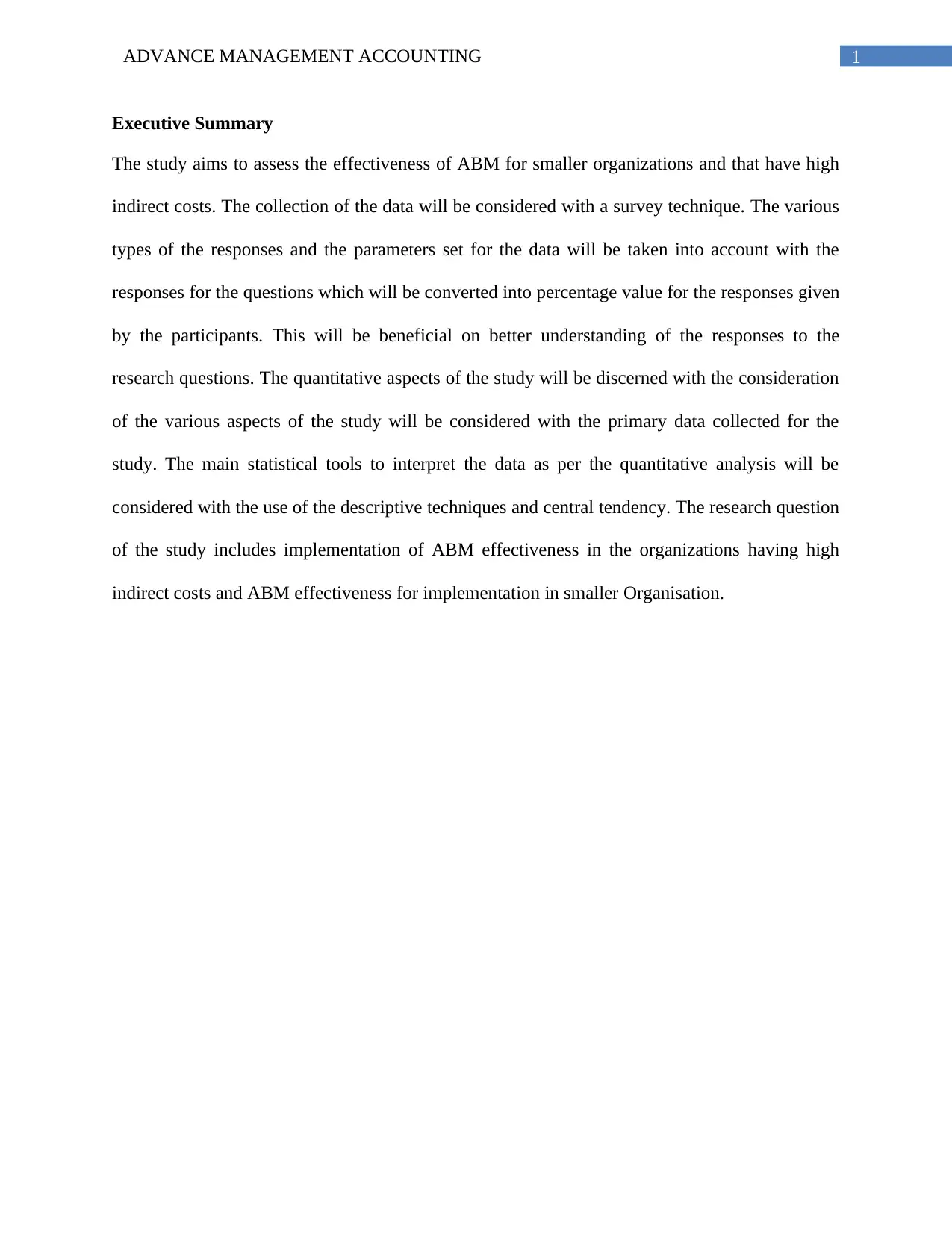
1ADVANCE MANAGEMENT ACCOUNTING
Executive Summary
The study aims to assess the effectiveness of ABM for smaller organizations and that have high
indirect costs. The collection of the data will be considered with a survey technique. The various
types of the responses and the parameters set for the data will be taken into account with the
responses for the questions which will be converted into percentage value for the responses given
by the participants. This will be beneficial on better understanding of the responses to the
research questions. The quantitative aspects of the study will be discerned with the consideration
of the various aspects of the study will be considered with the primary data collected for the
study. The main statistical tools to interpret the data as per the quantitative analysis will be
considered with the use of the descriptive techniques and central tendency. The research question
of the study includes implementation of ABM effectiveness in the organizations having high
indirect costs and ABM effectiveness for implementation in smaller Organisation.
Executive Summary
The study aims to assess the effectiveness of ABM for smaller organizations and that have high
indirect costs. The collection of the data will be considered with a survey technique. The various
types of the responses and the parameters set for the data will be taken into account with the
responses for the questions which will be converted into percentage value for the responses given
by the participants. This will be beneficial on better understanding of the responses to the
research questions. The quantitative aspects of the study will be discerned with the consideration
of the various aspects of the study will be considered with the primary data collected for the
study. The main statistical tools to interpret the data as per the quantitative analysis will be
considered with the use of the descriptive techniques and central tendency. The research question
of the study includes implementation of ABM effectiveness in the organizations having high
indirect costs and ABM effectiveness for implementation in smaller Organisation.
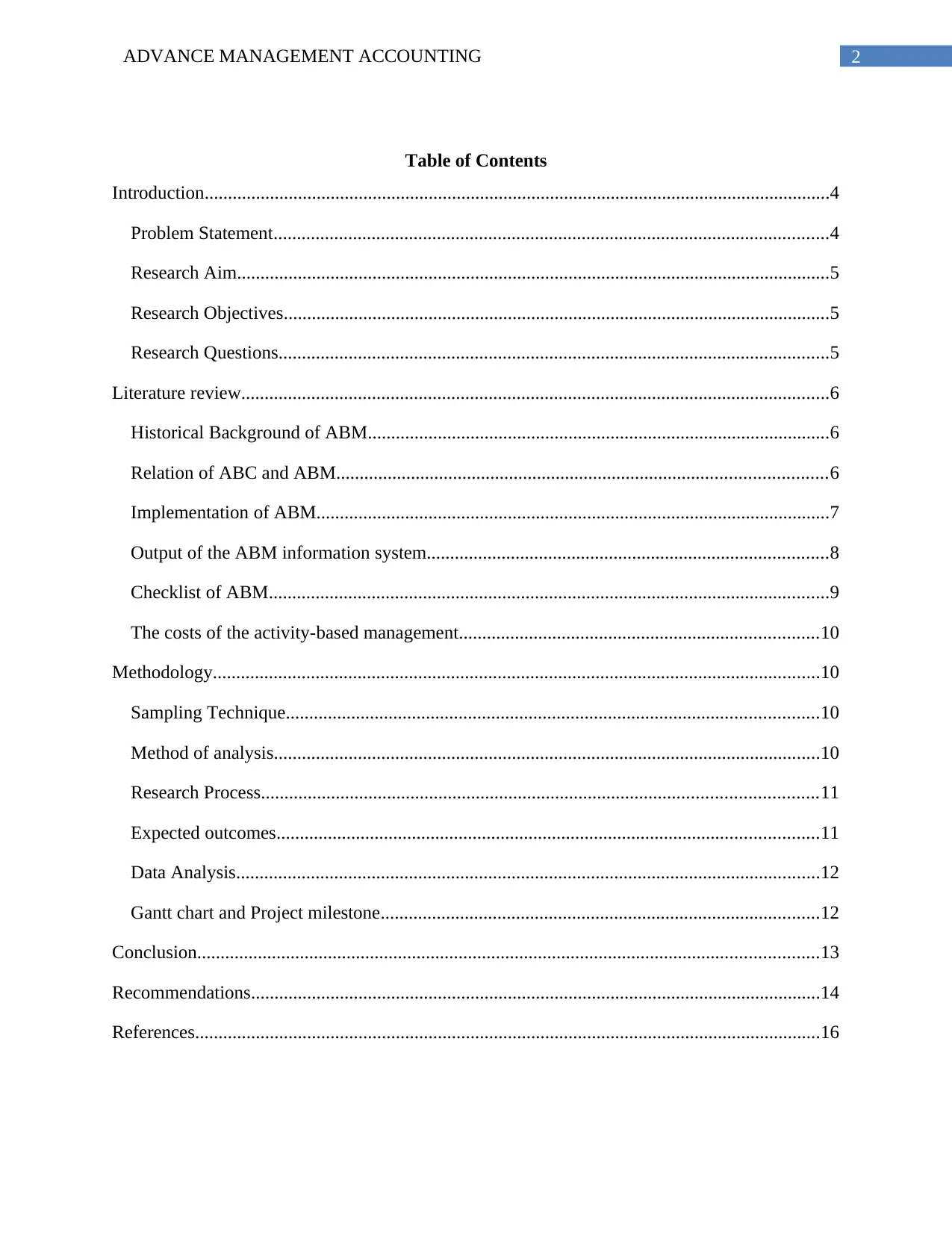
2ADVANCE MANAGEMENT ACCOUNTING
Table of Contents
Introduction......................................................................................................................................4
Problem Statement.......................................................................................................................4
Research Aim...............................................................................................................................5
Research Objectives.....................................................................................................................5
Research Questions......................................................................................................................5
Literature review..............................................................................................................................6
Historical Background of ABM...................................................................................................6
Relation of ABC and ABM.........................................................................................................6
Implementation of ABM..............................................................................................................7
Output of the ABM information system......................................................................................8
Checklist of ABM........................................................................................................................9
The costs of the activity-based management.............................................................................10
Methodology..................................................................................................................................10
Sampling Technique..................................................................................................................10
Method of analysis.....................................................................................................................10
Research Process.......................................................................................................................11
Expected outcomes....................................................................................................................11
Data Analysis.............................................................................................................................12
Gantt chart and Project milestone..............................................................................................12
Conclusion.....................................................................................................................................13
Recommendations..........................................................................................................................14
References......................................................................................................................................16
Table of Contents
Introduction......................................................................................................................................4
Problem Statement.......................................................................................................................4
Research Aim...............................................................................................................................5
Research Objectives.....................................................................................................................5
Research Questions......................................................................................................................5
Literature review..............................................................................................................................6
Historical Background of ABM...................................................................................................6
Relation of ABC and ABM.........................................................................................................6
Implementation of ABM..............................................................................................................7
Output of the ABM information system......................................................................................8
Checklist of ABM........................................................................................................................9
The costs of the activity-based management.............................................................................10
Methodology..................................................................................................................................10
Sampling Technique..................................................................................................................10
Method of analysis.....................................................................................................................10
Research Process.......................................................................................................................11
Expected outcomes....................................................................................................................11
Data Analysis.............................................................................................................................12
Gantt chart and Project milestone..............................................................................................12
Conclusion.....................................................................................................................................13
Recommendations..........................................................................................................................14
References......................................................................................................................................16
⊘ This is a preview!⊘
Do you want full access?
Subscribe today to unlock all pages.

Trusted by 1+ million students worldwide
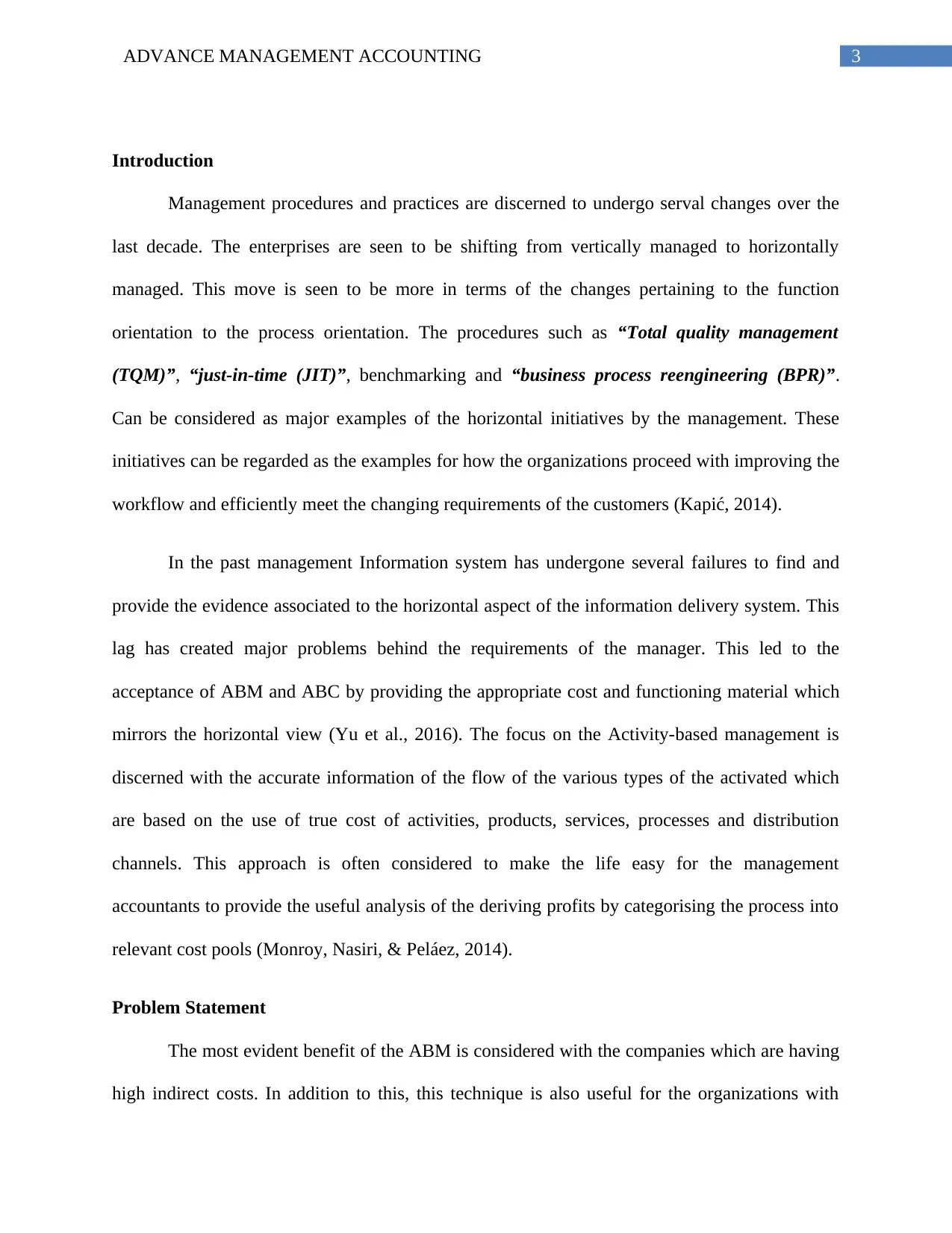
3ADVANCE MANAGEMENT ACCOUNTING
Introduction
Management procedures and practices are discerned to undergo serval changes over the
last decade. The enterprises are seen to be shifting from vertically managed to horizontally
managed. This move is seen to be more in terms of the changes pertaining to the function
orientation to the process orientation. The procedures such as “Total quality management
(TQM)”, “just-in-time (JIT)”, benchmarking and “business process reengineering (BPR)”.
Can be considered as major examples of the horizontal initiatives by the management. These
initiatives can be regarded as the examples for how the organizations proceed with improving the
workflow and efficiently meet the changing requirements of the customers (Kapić, 2014).
In the past management Information system has undergone several failures to find and
provide the evidence associated to the horizontal aspect of the information delivery system. This
lag has created major problems behind the requirements of the manager. This led to the
acceptance of ABM and ABC by providing the appropriate cost and functioning material which
mirrors the horizontal view (Yu et al., 2016). The focus on the Activity-based management is
discerned with the accurate information of the flow of the various types of the activated which
are based on the use of true cost of activities, products, services, processes and distribution
channels. This approach is often considered to make the life easy for the management
accountants to provide the useful analysis of the deriving profits by categorising the process into
relevant cost pools (Monroy, Nasiri, & Peláez, 2014).
Problem Statement
The most evident benefit of the ABM is considered with the companies which are having
high indirect costs. In addition to this, this technique is also useful for the organizations with
Introduction
Management procedures and practices are discerned to undergo serval changes over the
last decade. The enterprises are seen to be shifting from vertically managed to horizontally
managed. This move is seen to be more in terms of the changes pertaining to the function
orientation to the process orientation. The procedures such as “Total quality management
(TQM)”, “just-in-time (JIT)”, benchmarking and “business process reengineering (BPR)”.
Can be considered as major examples of the horizontal initiatives by the management. These
initiatives can be regarded as the examples for how the organizations proceed with improving the
workflow and efficiently meet the changing requirements of the customers (Kapić, 2014).
In the past management Information system has undergone several failures to find and
provide the evidence associated to the horizontal aspect of the information delivery system. This
lag has created major problems behind the requirements of the manager. This led to the
acceptance of ABM and ABC by providing the appropriate cost and functioning material which
mirrors the horizontal view (Yu et al., 2016). The focus on the Activity-based management is
discerned with the accurate information of the flow of the various types of the activated which
are based on the use of true cost of activities, products, services, processes and distribution
channels. This approach is often considered to make the life easy for the management
accountants to provide the useful analysis of the deriving profits by categorising the process into
relevant cost pools (Monroy, Nasiri, & Peláez, 2014).
Problem Statement
The most evident benefit of the ABM is considered with the companies which are having
high indirect costs. In addition to this, this technique is also useful for the organizations with
Paraphrase This Document
Need a fresh take? Get an instant paraphrase of this document with our AI Paraphraser
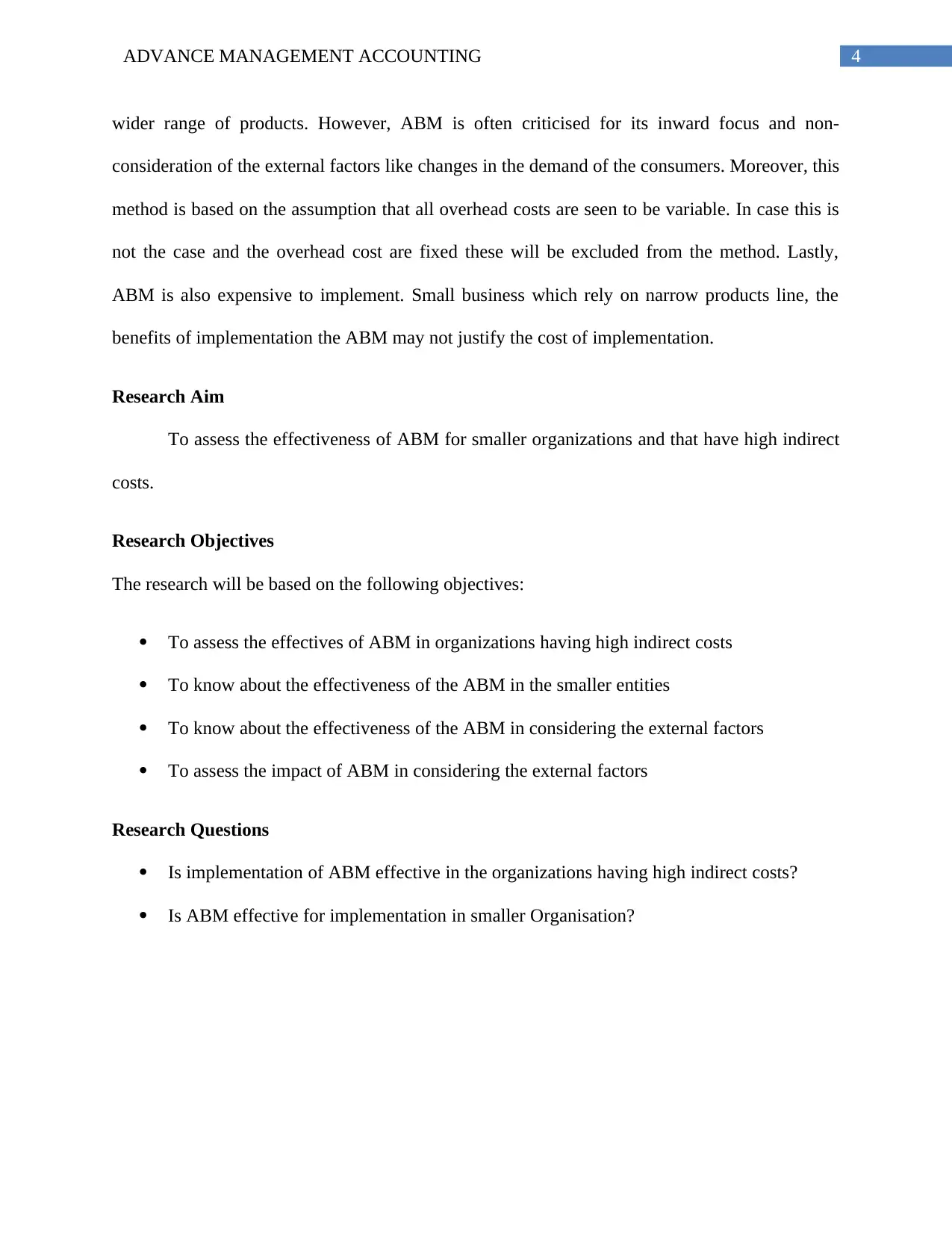
4ADVANCE MANAGEMENT ACCOUNTING
wider range of products. However, ABM is often criticised for its inward focus and non-
consideration of the external factors like changes in the demand of the consumers. Moreover, this
method is based on the assumption that all overhead costs are seen to be variable. In case this is
not the case and the overhead cost are fixed these will be excluded from the method. Lastly,
ABM is also expensive to implement. Small business which rely on narrow products line, the
benefits of implementation the ABM may not justify the cost of implementation.
Research Aim
To assess the effectiveness of ABM for smaller organizations and that have high indirect
costs.
Research Objectives
The research will be based on the following objectives:
To assess the effectives of ABM in organizations having high indirect costs
To know about the effectiveness of the ABM in the smaller entities
To know about the effectiveness of the ABM in considering the external factors
To assess the impact of ABM in considering the external factors
Research Questions
Is implementation of ABM effective in the organizations having high indirect costs?
Is ABM effective for implementation in smaller Organisation?
wider range of products. However, ABM is often criticised for its inward focus and non-
consideration of the external factors like changes in the demand of the consumers. Moreover, this
method is based on the assumption that all overhead costs are seen to be variable. In case this is
not the case and the overhead cost are fixed these will be excluded from the method. Lastly,
ABM is also expensive to implement. Small business which rely on narrow products line, the
benefits of implementation the ABM may not justify the cost of implementation.
Research Aim
To assess the effectiveness of ABM for smaller organizations and that have high indirect
costs.
Research Objectives
The research will be based on the following objectives:
To assess the effectives of ABM in organizations having high indirect costs
To know about the effectiveness of the ABM in the smaller entities
To know about the effectiveness of the ABM in considering the external factors
To assess the impact of ABM in considering the external factors
Research Questions
Is implementation of ABM effective in the organizations having high indirect costs?
Is ABM effective for implementation in smaller Organisation?
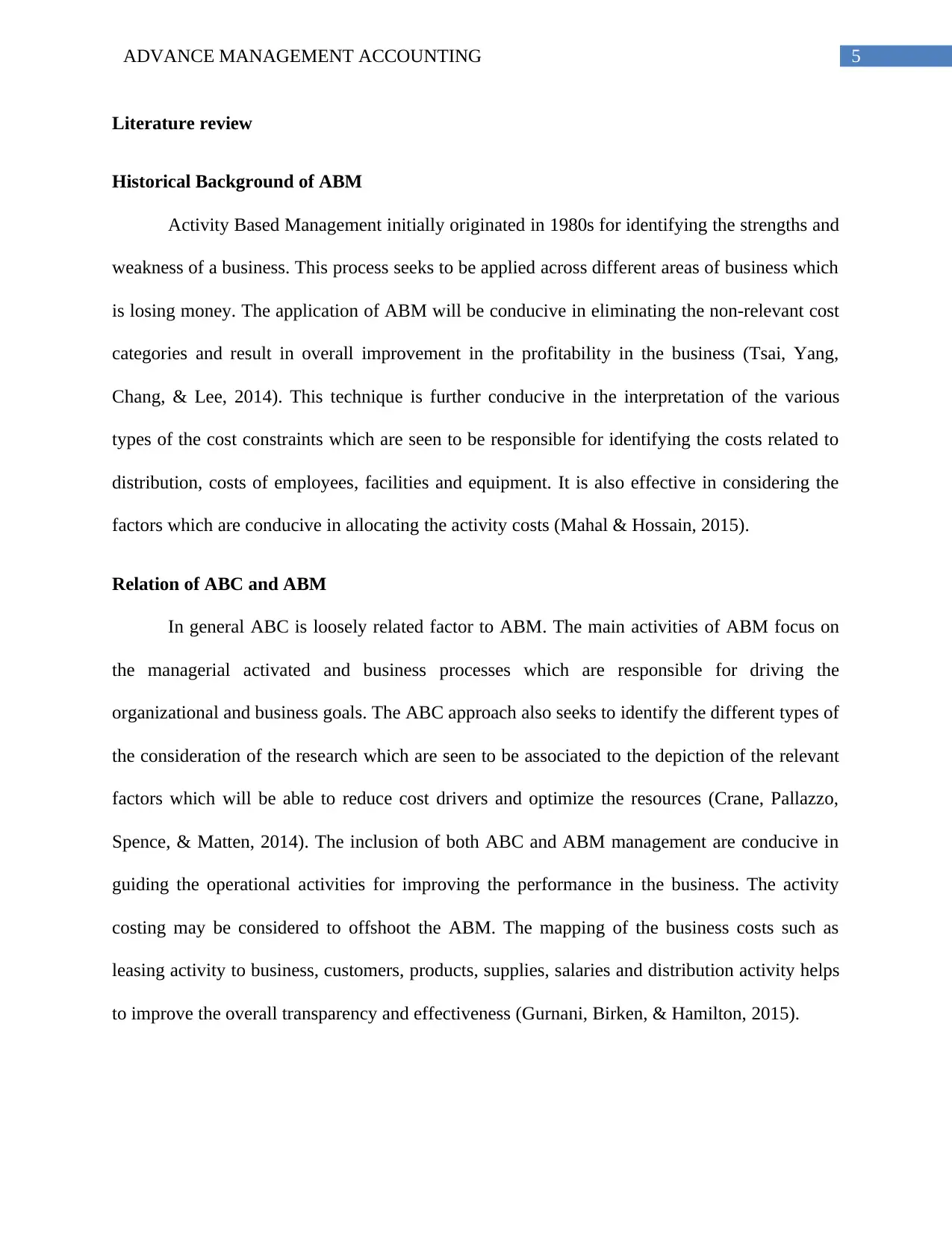
5ADVANCE MANAGEMENT ACCOUNTING
Literature review
Historical Background of ABM
Activity Based Management initially originated in 1980s for identifying the strengths and
weakness of a business. This process seeks to be applied across different areas of business which
is losing money. The application of ABM will be conducive in eliminating the non-relevant cost
categories and result in overall improvement in the profitability in the business (Tsai, Yang,
Chang, & Lee, 2014). This technique is further conducive in the interpretation of the various
types of the cost constraints which are seen to be responsible for identifying the costs related to
distribution, costs of employees, facilities and equipment. It is also effective in considering the
factors which are conducive in allocating the activity costs (Mahal & Hossain, 2015).
Relation of ABC and ABM
In general ABC is loosely related factor to ABM. The main activities of ABM focus on
the managerial activated and business processes which are responsible for driving the
organizational and business goals. The ABC approach also seeks to identify the different types of
the consideration of the research which are seen to be associated to the depiction of the relevant
factors which will be able to reduce cost drivers and optimize the resources (Crane, Pallazzo,
Spence, & Matten, 2014). The inclusion of both ABC and ABM management are conducive in
guiding the operational activities for improving the performance in the business. The activity
costing may be considered to offshoot the ABM. The mapping of the business costs such as
leasing activity to business, customers, products, supplies, salaries and distribution activity helps
to improve the overall transparency and effectiveness (Gurnani, Birken, & Hamilton, 2015).
Literature review
Historical Background of ABM
Activity Based Management initially originated in 1980s for identifying the strengths and
weakness of a business. This process seeks to be applied across different areas of business which
is losing money. The application of ABM will be conducive in eliminating the non-relevant cost
categories and result in overall improvement in the profitability in the business (Tsai, Yang,
Chang, & Lee, 2014). This technique is further conducive in the interpretation of the various
types of the cost constraints which are seen to be responsible for identifying the costs related to
distribution, costs of employees, facilities and equipment. It is also effective in considering the
factors which are conducive in allocating the activity costs (Mahal & Hossain, 2015).
Relation of ABC and ABM
In general ABC is loosely related factor to ABM. The main activities of ABM focus on
the managerial activated and business processes which are responsible for driving the
organizational and business goals. The ABC approach also seeks to identify the different types of
the consideration of the research which are seen to be associated to the depiction of the relevant
factors which will be able to reduce cost drivers and optimize the resources (Crane, Pallazzo,
Spence, & Matten, 2014). The inclusion of both ABC and ABM management are conducive in
guiding the operational activities for improving the performance in the business. The activity
costing may be considered to offshoot the ABM. The mapping of the business costs such as
leasing activity to business, customers, products, supplies, salaries and distribution activity helps
to improve the overall transparency and effectiveness (Gurnani, Birken, & Hamilton, 2015).
⊘ This is a preview!⊘
Do you want full access?
Subscribe today to unlock all pages.

Trusted by 1+ million students worldwide
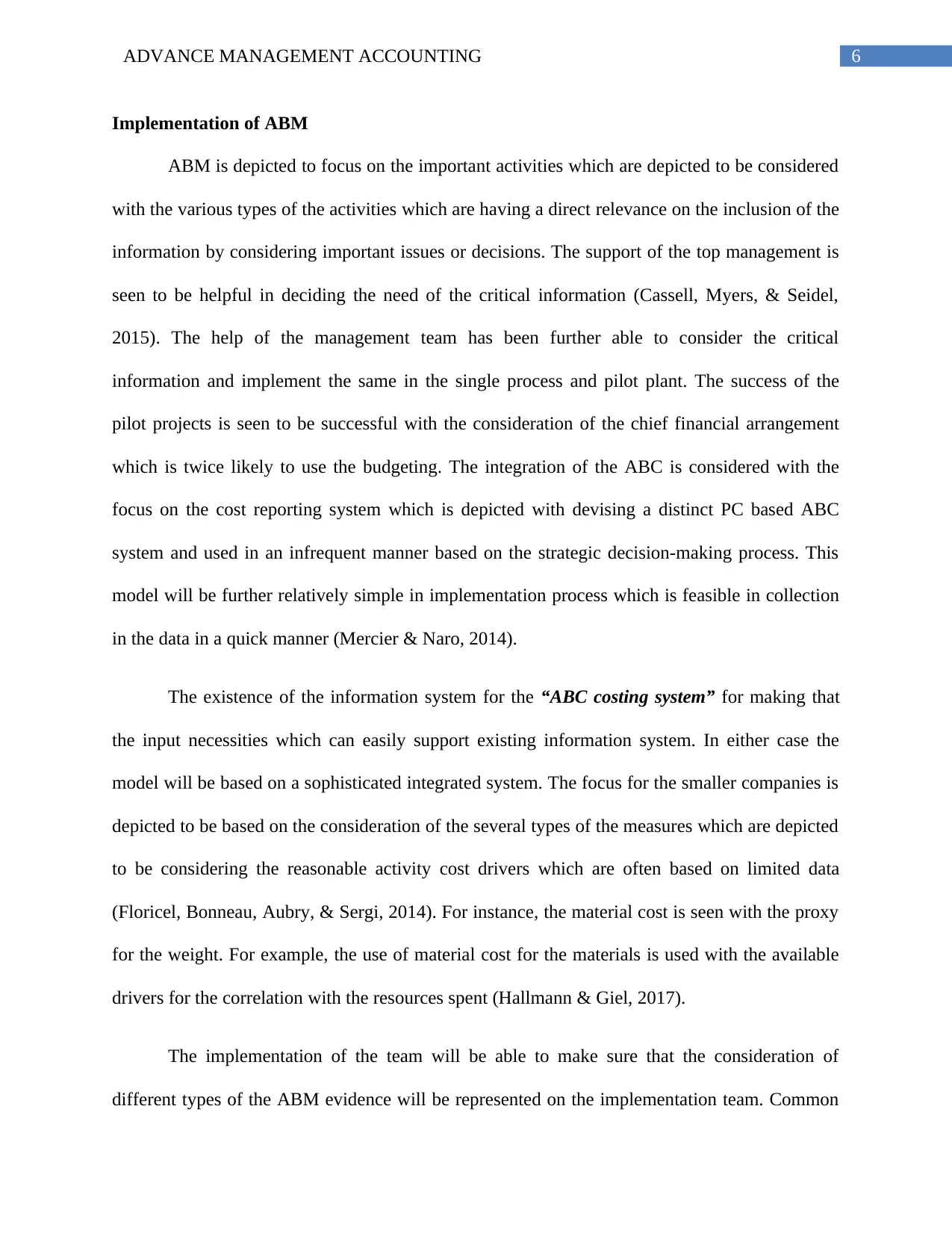
6ADVANCE MANAGEMENT ACCOUNTING
Implementation of ABM
ABM is depicted to focus on the important activities which are depicted to be considered
with the various types of the activities which are having a direct relevance on the inclusion of the
information by considering important issues or decisions. The support of the top management is
seen to be helpful in deciding the need of the critical information (Cassell, Myers, & Seidel,
2015). The help of the management team has been further able to consider the critical
information and implement the same in the single process and pilot plant. The success of the
pilot projects is seen to be successful with the consideration of the chief financial arrangement
which is twice likely to use the budgeting. The integration of the ABC is considered with the
focus on the cost reporting system which is depicted with devising a distinct PC based ABC
system and used in an infrequent manner based on the strategic decision-making process. This
model will be further relatively simple in implementation process which is feasible in collection
in the data in a quick manner (Mercier & Naro, 2014).
The existence of the information system for the “ABC costing system” for making that
the input necessities which can easily support existing information system. In either case the
model will be based on a sophisticated integrated system. The focus for the smaller companies is
depicted to be based on the consideration of the several types of the measures which are depicted
to be considering the reasonable activity cost drivers which are often based on limited data
(Floricel, Bonneau, Aubry, & Sergi, 2014). For instance, the material cost is seen with the proxy
for the weight. For example, the use of material cost for the materials is used with the available
drivers for the correlation with the resources spent (Hallmann & Giel, 2017).
The implementation of the team will be able to make sure that the consideration of
different types of the ABM evidence will be represented on the implementation team. Common
Implementation of ABM
ABM is depicted to focus on the important activities which are depicted to be considered
with the various types of the activities which are having a direct relevance on the inclusion of the
information by considering important issues or decisions. The support of the top management is
seen to be helpful in deciding the need of the critical information (Cassell, Myers, & Seidel,
2015). The help of the management team has been further able to consider the critical
information and implement the same in the single process and pilot plant. The success of the
pilot projects is seen to be successful with the consideration of the chief financial arrangement
which is twice likely to use the budgeting. The integration of the ABC is considered with the
focus on the cost reporting system which is depicted with devising a distinct PC based ABC
system and used in an infrequent manner based on the strategic decision-making process. This
model will be further relatively simple in implementation process which is feasible in collection
in the data in a quick manner (Mercier & Naro, 2014).
The existence of the information system for the “ABC costing system” for making that
the input necessities which can easily support existing information system. In either case the
model will be based on a sophisticated integrated system. The focus for the smaller companies is
depicted to be based on the consideration of the several types of the measures which are depicted
to be considering the reasonable activity cost drivers which are often based on limited data
(Floricel, Bonneau, Aubry, & Sergi, 2014). For instance, the material cost is seen with the proxy
for the weight. For example, the use of material cost for the materials is used with the available
drivers for the correlation with the resources spent (Hallmann & Giel, 2017).
The implementation of the team will be able to make sure that the consideration of
different types of the ABM evidence will be represented on the implementation team. Common
Paraphrase This Document
Need a fresh take? Get an instant paraphrase of this document with our AI Paraphraser
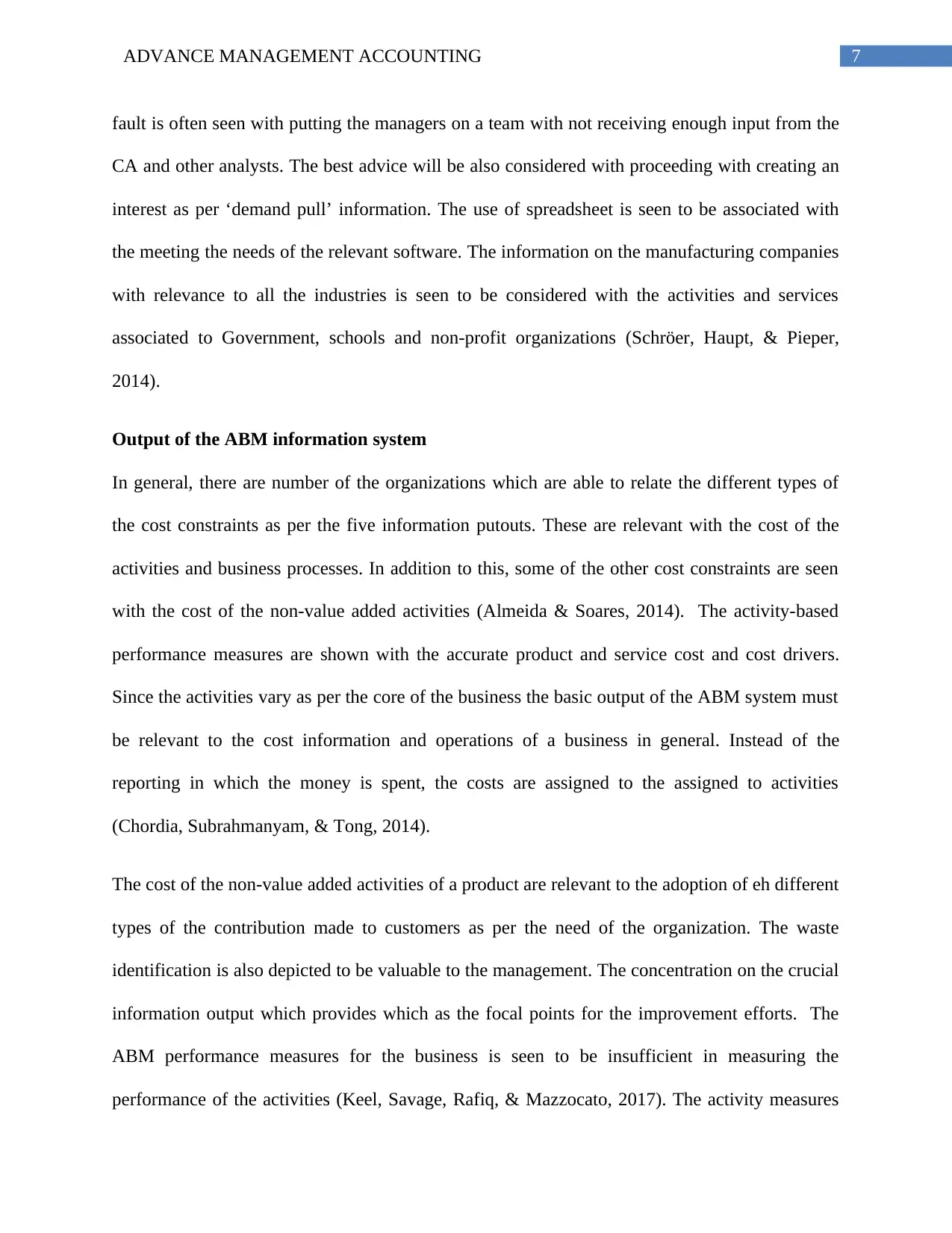
7ADVANCE MANAGEMENT ACCOUNTING
fault is often seen with putting the managers on a team with not receiving enough input from the
CA and other analysts. The best advice will be also considered with proceeding with creating an
interest as per ‘demand pull’ information. The use of spreadsheet is seen to be associated with
the meeting the needs of the relevant software. The information on the manufacturing companies
with relevance to all the industries is seen to be considered with the activities and services
associated to Government, schools and non-profit organizations (Schröer, Haupt, & Pieper,
2014).
Output of the ABM information system
In general, there are number of the organizations which are able to relate the different types of
the cost constraints as per the five information putouts. These are relevant with the cost of the
activities and business processes. In addition to this, some of the other cost constraints are seen
with the cost of the non-value added activities (Almeida & Soares, 2014). The activity-based
performance measures are shown with the accurate product and service cost and cost drivers.
Since the activities vary as per the core of the business the basic output of the ABM system must
be relevant to the cost information and operations of a business in general. Instead of the
reporting in which the money is spent, the costs are assigned to the assigned to activities
(Chordia, Subrahmanyam, & Tong, 2014).
The cost of the non-value added activities of a product are relevant to the adoption of eh different
types of the contribution made to customers as per the need of the organization. The waste
identification is also depicted to be valuable to the management. The concentration on the crucial
information output which provides which as the focal points for the improvement efforts. The
ABM performance measures for the business is seen to be insufficient in measuring the
performance of the activities (Keel, Savage, Rafiq, & Mazzocato, 2017). The activity measures
fault is often seen with putting the managers on a team with not receiving enough input from the
CA and other analysts. The best advice will be also considered with proceeding with creating an
interest as per ‘demand pull’ information. The use of spreadsheet is seen to be associated with
the meeting the needs of the relevant software. The information on the manufacturing companies
with relevance to all the industries is seen to be considered with the activities and services
associated to Government, schools and non-profit organizations (Schröer, Haupt, & Pieper,
2014).
Output of the ABM information system
In general, there are number of the organizations which are able to relate the different types of
the cost constraints as per the five information putouts. These are relevant with the cost of the
activities and business processes. In addition to this, some of the other cost constraints are seen
with the cost of the non-value added activities (Almeida & Soares, 2014). The activity-based
performance measures are shown with the accurate product and service cost and cost drivers.
Since the activities vary as per the core of the business the basic output of the ABM system must
be relevant to the cost information and operations of a business in general. Instead of the
reporting in which the money is spent, the costs are assigned to the assigned to activities
(Chordia, Subrahmanyam, & Tong, 2014).
The cost of the non-value added activities of a product are relevant to the adoption of eh different
types of the contribution made to customers as per the need of the organization. The waste
identification is also depicted to be valuable to the management. The concentration on the crucial
information output which provides which as the focal points for the improvement efforts. The
ABM performance measures for the business is seen to be insufficient in measuring the
performance of the activities (Keel, Savage, Rafiq, & Mazzocato, 2017). The activity measures

8ADVANCE MANAGEMENT ACCOUNTING
are associated of the quality cycle, productivity and customer service. The performance
measurement activities are further conducive in providing the scorecard for reporting showing
the effectiveness of the improvement measures taken by the company. The services and the
products are provided was per the needs of the customers and market with the considerations of
several distribution channels and contractual relationship. The services and products are often
seen to depict consumption of the resources at varied rates and need the support of the costs
constraints along with accuracy in its determination (Nieves, Quintana, & Osorio, 2014).
The accuracy in the services and products are important for selecting the segmented
markets and individuals in which the organizations competes with the pricing for the markets.
The accuracy in the services and products are also important for getting the key information on
the adoption of the ABM systems (Scott & Van Blyderveen, 2014). The final output of the ABM
can be discerned as the cost driver’s information. This information is essential for suggesting
about the changes in the cost of the activity. For instance, quality of the parts received are
determined as per the factors which are developed as per the depiction of the resources required
platform associated with the multiple cost drivers (Kaplan et al., 2015).
Checklist of ABM
The implementation of ABM often fails because the time to identify the delivery of the
required outputs. The organization needs to identify the correct approach for the delivery of the
required outputs. The organizations often decide on the objectives of the ABM implementation
of the project along with the users and put the information when created. The particular
circumstances are often considered to be suitable for the business. The management overheads
are often seen to consider the operating units of the major concern for the business (Colberg et
al., 2016).
are associated of the quality cycle, productivity and customer service. The performance
measurement activities are further conducive in providing the scorecard for reporting showing
the effectiveness of the improvement measures taken by the company. The services and the
products are provided was per the needs of the customers and market with the considerations of
several distribution channels and contractual relationship. The services and products are often
seen to depict consumption of the resources at varied rates and need the support of the costs
constraints along with accuracy in its determination (Nieves, Quintana, & Osorio, 2014).
The accuracy in the services and products are important for selecting the segmented
markets and individuals in which the organizations competes with the pricing for the markets.
The accuracy in the services and products are also important for getting the key information on
the adoption of the ABM systems (Scott & Van Blyderveen, 2014). The final output of the ABM
can be discerned as the cost driver’s information. This information is essential for suggesting
about the changes in the cost of the activity. For instance, quality of the parts received are
determined as per the factors which are developed as per the depiction of the resources required
platform associated with the multiple cost drivers (Kaplan et al., 2015).
Checklist of ABM
The implementation of ABM often fails because the time to identify the delivery of the
required outputs. The organization needs to identify the correct approach for the delivery of the
required outputs. The organizations often decide on the objectives of the ABM implementation
of the project along with the users and put the information when created. The particular
circumstances are often considered to be suitable for the business. The management overheads
are often seen to consider the operating units of the major concern for the business (Colberg et
al., 2016).
⊘ This is a preview!⊘
Do you want full access?
Subscribe today to unlock all pages.

Trusted by 1+ million students worldwide

9ADVANCE MANAGEMENT ACCOUNTING
The costs of the activity-based management
A study conducted by Peter Armstrong has stated that the ABM has checked a stock in
trade with at least one of the Big six consultancies which has operated devotedly. The application
of both ABM and ABC are represented with a major allowance of the answerability for the
modern corporation into a zone of previously defined accounting terms which are having a fixed
overhead (Yun et al., 2016). The mechanics for the staff department are also discerned with
treating the activities as per the presentation indicators and payroll budgets which may be linked
to the volumes of the staff employment and changes brought within the organizations (Barhoumi,
2015).
Methodology
Sampling Technique
The sample size selected for the primary study will be depicted with 100 respondents. In
addition to this, the considerations of the respondents of the study is further based on the
assumption of the various types of the respondents are categorised as per managers and
employees. The primary sample of respondents in the manager category is depicted as 30 and 70
in the employee’s category. The study will further implement simple random technique for the
given study. This will be conducive for the segregation of the data as per the rational basis which
will be conducive in the application of the final study (Kothari, Kumar, & Uusitalo, 2014).
Method of analysis
The collection of the data will be considered with a survey technique. The various types
of the responses and the parameters set for the data will be taken into account with the responses
for the questions which will be converted into percentage value for the responses given by the
The costs of the activity-based management
A study conducted by Peter Armstrong has stated that the ABM has checked a stock in
trade with at least one of the Big six consultancies which has operated devotedly. The application
of both ABM and ABC are represented with a major allowance of the answerability for the
modern corporation into a zone of previously defined accounting terms which are having a fixed
overhead (Yun et al., 2016). The mechanics for the staff department are also discerned with
treating the activities as per the presentation indicators and payroll budgets which may be linked
to the volumes of the staff employment and changes brought within the organizations (Barhoumi,
2015).
Methodology
Sampling Technique
The sample size selected for the primary study will be depicted with 100 respondents. In
addition to this, the considerations of the respondents of the study is further based on the
assumption of the various types of the respondents are categorised as per managers and
employees. The primary sample of respondents in the manager category is depicted as 30 and 70
in the employee’s category. The study will further implement simple random technique for the
given study. This will be conducive for the segregation of the data as per the rational basis which
will be conducive in the application of the final study (Kothari, Kumar, & Uusitalo, 2014).
Method of analysis
The collection of the data will be considered with a survey technique. The various types
of the responses and the parameters set for the data will be taken into account with the responses
for the questions which will be converted into percentage value for the responses given by the
Paraphrase This Document
Need a fresh take? Get an instant paraphrase of this document with our AI Paraphraser
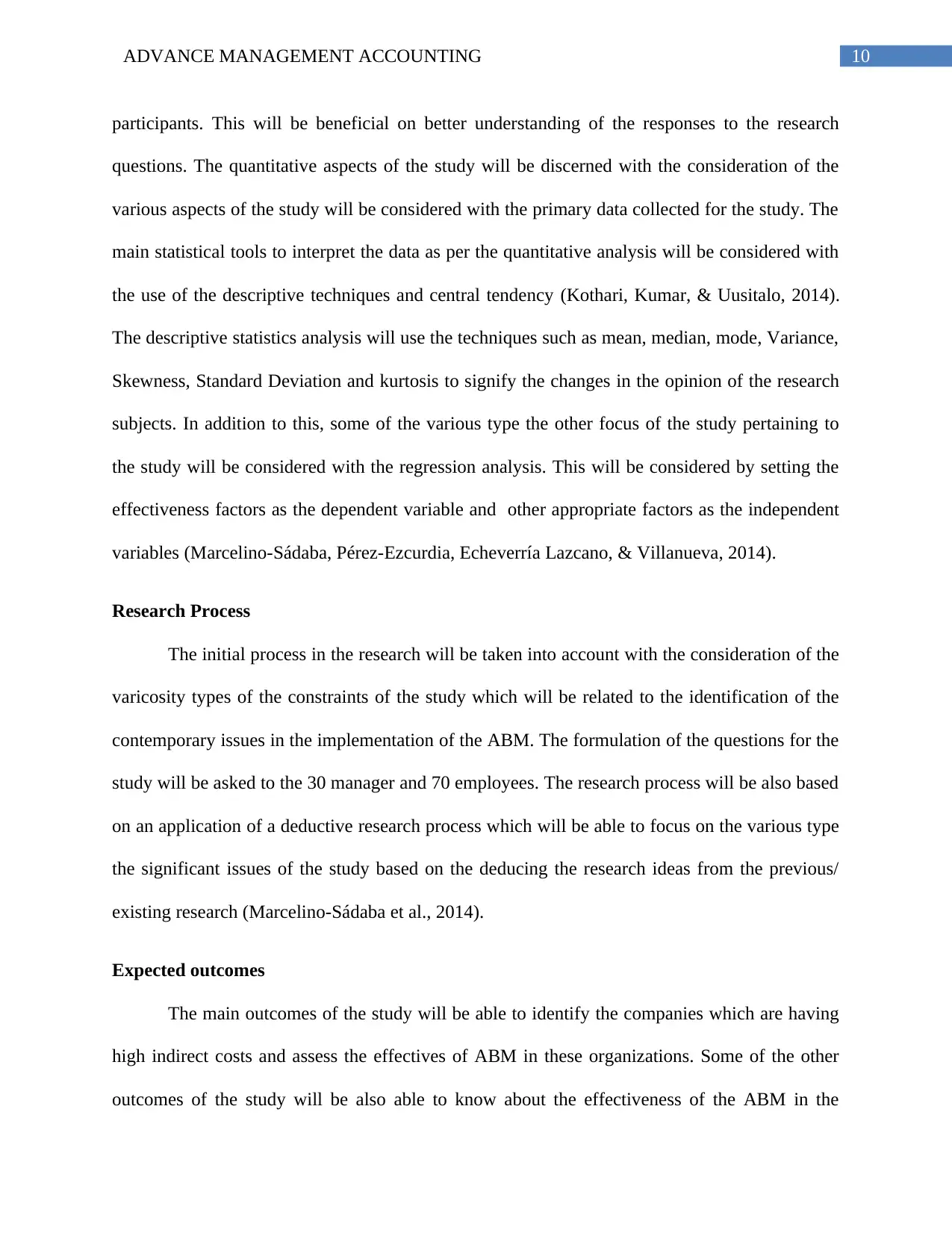
10ADVANCE MANAGEMENT ACCOUNTING
participants. This will be beneficial on better understanding of the responses to the research
questions. The quantitative aspects of the study will be discerned with the consideration of the
various aspects of the study will be considered with the primary data collected for the study. The
main statistical tools to interpret the data as per the quantitative analysis will be considered with
the use of the descriptive techniques and central tendency (Kothari, Kumar, & Uusitalo, 2014).
The descriptive statistics analysis will use the techniques such as mean, median, mode, Variance,
Skewness, Standard Deviation and kurtosis to signify the changes in the opinion of the research
subjects. In addition to this, some of the various type the other focus of the study pertaining to
the study will be considered with the regression analysis. This will be considered by setting the
effectiveness factors as the dependent variable and other appropriate factors as the independent
variables (Marcelino-Sádaba, Pérez-Ezcurdia, Echeverría Lazcano, & Villanueva, 2014).
Research Process
The initial process in the research will be taken into account with the consideration of the
varicosity types of the constraints of the study which will be related to the identification of the
contemporary issues in the implementation of the ABM. The formulation of the questions for the
study will be asked to the 30 manager and 70 employees. The research process will be also based
on an application of a deductive research process which will be able to focus on the various type
the significant issues of the study based on the deducing the research ideas from the previous/
existing research (Marcelino-Sádaba et al., 2014).
Expected outcomes
The main outcomes of the study will be able to identify the companies which are having
high indirect costs and assess the effectives of ABM in these organizations. Some of the other
outcomes of the study will be also able to know about the effectiveness of the ABM in the
participants. This will be beneficial on better understanding of the responses to the research
questions. The quantitative aspects of the study will be discerned with the consideration of the
various aspects of the study will be considered with the primary data collected for the study. The
main statistical tools to interpret the data as per the quantitative analysis will be considered with
the use of the descriptive techniques and central tendency (Kothari, Kumar, & Uusitalo, 2014).
The descriptive statistics analysis will use the techniques such as mean, median, mode, Variance,
Skewness, Standard Deviation and kurtosis to signify the changes in the opinion of the research
subjects. In addition to this, some of the various type the other focus of the study pertaining to
the study will be considered with the regression analysis. This will be considered by setting the
effectiveness factors as the dependent variable and other appropriate factors as the independent
variables (Marcelino-Sádaba, Pérez-Ezcurdia, Echeverría Lazcano, & Villanueva, 2014).
Research Process
The initial process in the research will be taken into account with the consideration of the
varicosity types of the constraints of the study which will be related to the identification of the
contemporary issues in the implementation of the ABM. The formulation of the questions for the
study will be asked to the 30 manager and 70 employees. The research process will be also based
on an application of a deductive research process which will be able to focus on the various type
the significant issues of the study based on the deducing the research ideas from the previous/
existing research (Marcelino-Sádaba et al., 2014).
Expected outcomes
The main outcomes of the study will be able to identify the companies which are having
high indirect costs and assess the effectives of ABM in these organizations. Some of the other
outcomes of the study will be also able to know about the effectiveness of the ABM in the

11ADVANCE MANAGEMENT ACCOUNTING
smaller entities and considering the external factors. Lastly, the study will be also able to specify
the various types of the specification of the implementation of the ABM by considering the
effective as per the external factors (Perumal, 2014).
Data Analysis
The study will be primarily based on the analysis of the data as per the statistical
interpretations. Some of the different types of the aspects of the research will be take into
account use of techniques such as mean, median, mode, Variance, Skewness, Standard Deviation
and kurtosis to signify the changes in the opinion of the research subjects. In addition to this,
some of the various type the other focus of the study pertaining to the study will be considered
with the regression analysis. This will be considered by setting the effectiveness factors as the
dependent variable and other appropriate factors as the independent variables. The secondary
analysis of the interpretations of the data will be also taken into account. These depictions will be
considered with the previous journal articles and e-books (Bloomberg & Volpe, 2014).
Gantt chart and Project milestone
Sequential
Activities/
Period
Week 1 Week 2 Week 3 &4 Week 5 & 6
Formulation of
the project idea
Designing
process for the
smaller entities and considering the external factors. Lastly, the study will be also able to specify
the various types of the specification of the implementation of the ABM by considering the
effective as per the external factors (Perumal, 2014).
Data Analysis
The study will be primarily based on the analysis of the data as per the statistical
interpretations. Some of the different types of the aspects of the research will be take into
account use of techniques such as mean, median, mode, Variance, Skewness, Standard Deviation
and kurtosis to signify the changes in the opinion of the research subjects. In addition to this,
some of the various type the other focus of the study pertaining to the study will be considered
with the regression analysis. This will be considered by setting the effectiveness factors as the
dependent variable and other appropriate factors as the independent variables. The secondary
analysis of the interpretations of the data will be also taken into account. These depictions will be
considered with the previous journal articles and e-books (Bloomberg & Volpe, 2014).
Gantt chart and Project milestone
Sequential
Activities/
Period
Week 1 Week 2 Week 3 &4 Week 5 & 6
Formulation of
the project idea
Designing
process for the
⊘ This is a preview!⊘
Do you want full access?
Subscribe today to unlock all pages.

Trusted by 1+ million students worldwide
1 out of 19